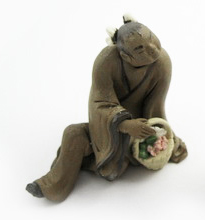Last month, I took a 3-session bonsai class and made my very first water-and-land penjing (penjing is bonsai in Chinese) in the bonsai workshop. Before taking this class, the idea of making my own water-and-land penjing was quite intimidating. I just never thought that I could build a penjing with such complex composition, involving design elements such as trees, rocks, mosses, water and figurines, all in harmony with each other and contribute to the whole penjing in a meaningful fashion.
For those who are not familiar with water-and-land penjing (水旱盆景, shuihan penjing), you can check out this post – The Main Categories of Chinese Bonsai (Penjing) – to learn more about the three main categories of Penjing.
And here, let me show you how to make a water-and-land penjing.
First, we build a shore front with stones to separate the land and the water in our penjing. In class, we used the small stones that we bought in Yingde (if you wonder what kind of place is Yingde, check out this post – Rocks for Landscape Penjing (Bonsai)). Try to show the best side of the rocks by having the most attractive parts of the rocks facing front. In addition, a curvy shoreline with different elevations looks more natural and interesting than one that is straight and flat 😉
Then, we add the glue – cement! Don’t move away the whole set of rocks, but do this one piece at a time. Or else you will forget the composition and can’t put the rocks back to how you have first designed them to be.
Put a layer of cement that is thick enough to block all the holes and cracks between the rocks. This is a very important step because we have to ensure that no water or soil can leak out through the cracks between the rocks.
After we have glued all rocks with cement, we let the cement dry out for a while first, maybe 15-20 minutes. Then we use a small paintbrush and water to clean up the excess cement on the rocks.
The less noticeable the cement is the better. We basically want to blend the cement with the rocks so that one cannot really tell where the cement is added when she/he is looking at the water-and-land penjing later.
And here I have the shoreline of my water-and-land penjing done. In the next post, I will show you how I made the “land” part of my water-and-land penjing.
























































